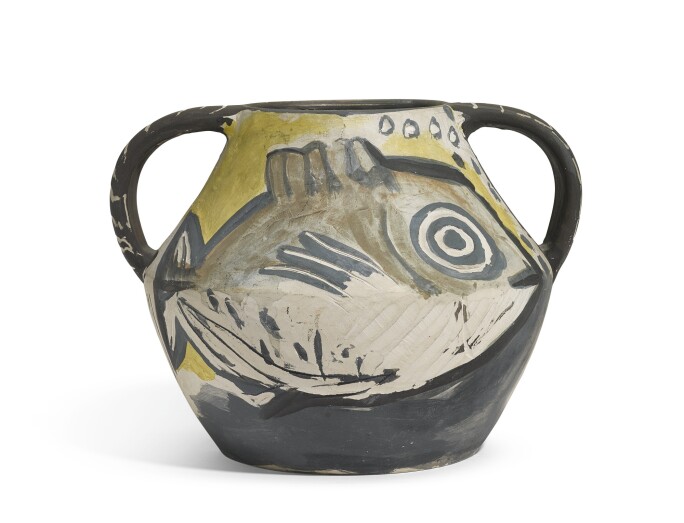A number of your works speak to the Modernist tradition of figures such as Pablo Picasso and Henri Matisse. Do you draw inspiration from artists like this?
I can’t help but admire the playful works of Picasso, the colour from Matisse and of course Lucie Rie’s form. My History of Art degree has played a big part in the way I look at form. At the time it felt like I was learning to be able read paintings and sculpture, in order to appreciate them, but it has now become a catalogue of art works that in some way or other moved me that I can draw on for inspiration. Lately I have become increasingly conscious of experimenting from within traditional shapes, which I suppose draws on Modernism.

The upcoming Picasso's Menagerie sale includes works such as his hand-carved plates, owl vases and other motifs. What can you learn from looking at these objects when thinking about your own studio practice?
Picasso’s ceramics were produced in what is considered one of the happiest stages of his life, and that has always resonated with me. I have also always felt that because ceramics were not his trademark medium, in some way perhaps he felt less pressure, and I think that translates from the work, and that encapsulation of lightness into the work is something I strive to do.
How do you begin to work on a piece – is it quite an intuitive process?
“if you know exactly what you’re going to do, what’s the point of doing it” – Pablo Picasso
I like to work on the wheel and hand building clay. The process of hand-building is slower and requires more patience; it is easier to plan what you’re going to build when coiling. The wheel is a speedier process, less sympathetic and more instinctive. I often try to draw beforehand what I then build, but it rarely looks the same as the finished product!

Can you talk a little bit about a day in the life in your studio?
I love being in my studio, where no two days are the same. Some days I’m fuzzy and the wheel is a perfect place to sit and meditate and make. When you’re making a pot, plate or piece of sculpture, there is nowhere else you’re allowed to be but in that moment, on the wheel working with your hands – it’s mindful and mindless bliss.
I am probably most fruitful when I walk into the studio with a plan, start with glazing, then wheel time, then a clean up. The journey home from the studio, covered in dust is when I try and visualise the next day’s progress and the anticipation of exposing the contents of tomorrow kiln begins.

Who is the person that you have in your mind when you are designing a piece?
My heart!
Is there a figure from history — or the present day — that inspires you the most?
I spent my summers as a child in Montpellier at John Skeaping’s house where the garden was full of sculpture, including an unforgettable Barbara Hepworth (Skeaping’s first wife). The creative ambiance that emanated from that place has always stuck with me.
I learned to trust my creative instinct, and to create for its own sake from my mother, also an artist. in my studio I am lucky to be surrounded by incredible ceramists, Chris Bramble, Freya Bramble, Iva Polachova all of whom are undeniably generous in their teachings.

Some of the pieces you produce have a poetic and playful element, (in particular your Je t’aime and Le Reve plates) but they are also functional objects. How do you marry the two together?
I love that an everyday item can be beautiful, unique, or funny and I always feel like it will give the user a smidgen more pleasure. I probably took the playful part a bit too far when I bit chunks out of the edges of my 'Bite Me' plate.

Picasso said: “Learn the rules like a pro, so you can break them like an artist.” – does that sentiment ring true to you?
The more I have honed my technique the more freedom I have felt at the wheel. I was accused by my French teachers as a child of being ‘vite et mal’ or ‘quickly and badly’, The best thing ceramics has taught me is patience. I can tell you that true heartbreak for a ceramicist is when a work comes out of the kiln, shattered; but that is normally because of a cut corner (speeding up the drying or glazing processes, or a rogue air bubble). You cannot speed up any process. Each process takes time, love and effort and sometimes you just have to pray to the Kiln Gods!
What is next for Florence St George? Are there any projects you are working on at the moment that you can share with us?
A selection of work is available at the Sladmore Gallery on Bruton street, or you can visit www.florencestgeorge.com for more of my works and ongoing projects.



